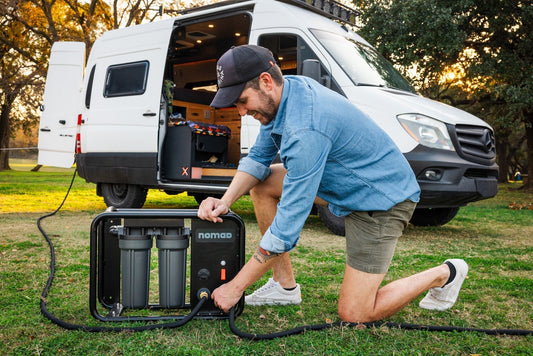You're hosting a dinner party, and as you fill glasses with water, that telltale orange tint appears. Your guests politely sip the metallic-tasting water while you internally cringe. If this scenario sounds familiar, you're not alone. Nearly 25% of American households deal with iron-contaminated well water, turning daily routines into embarrassing moments.
But here's the good news: the right well water iron removal systems can transform your rusty, stained water into crystal-clear refreshment. Whether you're dealing with stubborn orange stains on your fixtures or that unmistakable metallic taste, this guide will walk you through proven solutions that actually work.
The Hidden Enemy: Understanding Iron in Your Well Water
Before diving into solutions, let's understand what you're fighting. Iron doesn't just appear in your water overnight—it's been a silent passenger on a long journey through underground rock formations and soil layers.
Think of iron as nature's uninvited guest that overstays its welcome. When groundwater travels through iron-rich soil and rock, it picks up these minerals along the way. The result? Water that can contain anywhere from 0.3 to 10+ parts per million of iron—well above the EPA's recommended aesthetic guideline of 0.3 ppm.
Three Types of Iron: Know Your Enemy
Understanding how to remove iron from well water starts with identifying which type you're dealing with. Each behaves differently and requires specific removal strategies.
Ferrous Iron: The Invisible Troublemaker
Ferrous iron is sneaky. Your water looks crystal clear when it first comes out of the tap, but leave it sitting for a few minutes, and watch the magic show begin. As oxygen hits the water, ferrous iron oxidizes, turning your clear water into a rusty mess.

This "clear water iron" is dissolved in your water, making it harder to catch with basic filtration. It's like trying to catch smoke with a butterfly net—you need the right tools.
Ferric Iron: The Obvious Offender
Ferric iron doesn't hide. It's the reason your water looks like liquid rust straight from the tap. This oxidized form of iron gives water that distinctive reddish-brown color and leaves those stubborn stains on everything it touches.
The good news? Since ferric iron is already oxidized, it's easier to filter out using standard filtration methods.
Bacterial Iron: The Slimy Menace
Here's where things get interesting. Some bacteria actually feast on iron, creating a slimy, rust-colored biofilm that can clog pipes and create foul odors. If you've ever noticed a slimy, reddish residue in your toilet tank or pipes, you're likely dealing with bacterial iron.

Image by freepik
This type requires more aggressive treatment since you're not just removing iron—you're eliminating the bacteria producing it.
The Real Cost of Doing Nothing
Let's talk about what iron in your well water is actually costing you. Beyond the obvious embarrassment factor, iron damage adds up quickly:
- Appliance damage: Iron clogs water heaters, washing machines, and dishwashers, reducing their lifespan by 40-60%
- Plumbing issues: Iron buildup restricts water flow and can lead to costly pipe replacements
- Laundry disasters: White clothes turn orange, and no amount of bleach can save them
- Cleaning costs: Constant scrubbing of fixtures and surfaces adds hours to your cleaning routine
One customer shared that they spent over $2,000 replacing appliances damaged by iron before investing in proper filtration. Don't let that be your story.
The Cheapest Way to Remove Iron from Well Water
Looking for the cheapest way to remove iron from well water? The answer depends on your iron levels and type, but here's a cost-effective approach:
For Low Iron Levels (0.3-3 ppm)
Water Softener with Iron Removal Capability: A quality water softener can handle ferrous iron while also addressing hardness. This dual-purpose solution offers excellent value, typically costing $500-$1,500 installed.
For Medium Iron Levels (3-7 ppm)
Oxidizing Iron Filter: These systems force ferrous iron to oxidize, then trap it in a filter bed. Expect to invest $800-$2,500, but the long-term savings on appliance repair and replacement make it worthwhile.
For High Iron Levels (7+ ppm)
Multi-Stage Filtration System: Combining oxidation, filtration, and polishing stages ensures complete iron removal. While the upfront cost is higher ($1,500-$4,000), it's still cheaper than constantly replacing damaged appliances.
Top Iron Filter for Well Water Systems
Crystal Quest Whole House Iron Filter
This powerhouse system handles up to 15 ppm of iron while improving overall water quality. The multi-stage filtration process includes:
- Pre-filtration for sediment removal
- KDF media for iron reduction
- Carbon filtration for taste and odor improvement
- Post-filtration for crystal-clear results

Oxidizing Iron Filters: The Workhorses
These systems use media like manganese greensand or Birm to oxidize ferrous iron, making it filterable. They're particularly effective for moderate iron levels and require minimal maintenance.
Shock Treatment: The Nuclear Option
For bacterial iron, sometimes you need to bring out the big guns. Shock chlorination kills iron bacteria, but it's a temporary solution that requires professional implementation.
Installation and Maintenance: Keeping Your System Running
The best iron filter for well water is only as good as its maintenance. Here's what you need to know:
Professional Installation vs. DIY
While some homeowners tackle installation themselves, professional installation ensures:
- Proper sizing for your water usage
- Correct placement in your plumbing system
- Warranty protection
- Optimal performance from day one
Maintenance Requirements
Most iron removal systems require:
- Monthly backwashing (automated in quality systems)
- Annual media replacement or regeneration
- Periodic system cleaning
- Water testing to monitor performance

Choosing the Right System for Your Home
Selecting the perfect iron removal system involves several factors:
Water Testing: Your Starting Point
Before investing in any system, get a comprehensive water test. You need to know:
- Total iron content
- Iron type (ferrous, ferric, or bacterial)
- pH levels
- Hardness
- Other contaminants
Water Usage Considerations
A family of four uses approximately 300 gallons daily. Your system must handle peak demand without compromising performance.
Budget and Long-term Costs
Consider both upfront costs and ongoing expenses:
- Initial system cost
- Installation fees
- Monthly operating costs
- Annual maintenance
- Media replacement
Real Results: Customer Success Stories
Sarah from Pennsylvania shared: "After installing our Crystal Quest iron filter, our white laundry stayed white for the first time in five years. The metallic taste is completely gone, and guests actually compliment our water now."
Mike from Ohio added: "We chose the oxidizing filter route for our 8 ppm iron problem. Six months later, no orange stains anywhere, and our water heater is running more efficiently than ever."
Making the Decision: Your Next Steps
Ready to say goodbye to iron problems? Here's your action plan:
- Test your water to determine iron levels and type
- Calculate your budget including installation and maintenance
- Choose a system that matches your needs and usage
- Schedule professional installation for optimal performance
- Establish a maintenance routine to protect your investment
Remember, the best iron removal system is the one that fits your specific situation. Don't let iron continue damaging your appliances and embarrassing you in front of guests.
Frequently Asked Questions
What iron level requires a removal system?
Any level above 0.3 ppm creates staining and taste issues. Most homeowners notice problems at 0.5 ppm and definitely need treatment at 1 ppm or higher.
How often should I replace iron filter media?
Media replacement depends on iron levels and water usage. Typically every 3-5 years for oxidizing media, annually for some carbon components.
Can I install an iron filter myself?
While possible, professional installation ensures proper sizing, placement, and warranty coverage. DIY installation often leads to performance issues.
Do iron filters remove other contaminants?
Many iron removal systems also address hardness, sediment, and chlorine taste/odor. Multi-stage systems provide comprehensive water treatment.
How much does professional installation cost?
Professional installation typically adds $300-$800 to your system cost, depending on complexity and local rates.





